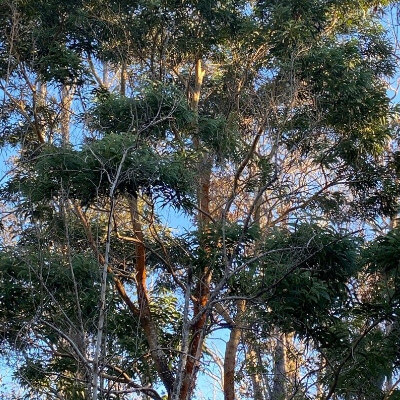
The Acacia koa, commonly known simply as “Koa”, is a symbol of the Hawaiian forests. A proud member of the Fabaceae family, it stands out for its impressive height and distinctive foliage. Reaching between 15 and 25 metres in height, this majestic tree is native to the Hawaiian Islands, where it plays a vital role in the local ecosystems. Its leaves — or more precisely, phyllodes — are elegantly curved, their vivid green colour providing a striking contrast to the dark, sturdy brown trunk.
Koa thrives in well-drained, nutrient-rich volcanic soils, typically found at altitudes ranging from 600 to 2,000 metres. Its rapid growth and ability to fix nitrogen in the soil underscore its ecological importance. At the Au Bois Vert Botanical Garden in Ivato, near Antananarivo, the Acacia koa holds a special place. Visitors are drawn to its graceful form and ornamental charm, while also being encouraged to reflect on the challenges of preserving endemic species.
This tree also produces delicate flowers. Its pale yellow blooms form small spherical clusters, adding a subtle yet beautiful touch to its appearance. Flowering usually takes place from winter through early spring, depending on the climate.
But the Acacia koa is more than just a pretty tree. It holds deep cultural significance in Polynesian heritage and plays a key role in the fine timber trade. Found in places such as hotels, restaurants, and lodges, it contributes to a calming, natural atmosphere — perfect for visitors seeking peace and tranquillity. This botanical gem invites people to discover the rich biodiversity of tropical ecosystems, particularly within the grounds of the Au Bois Vert Garden.
Plant use
The Acacia koa is primarily valued for its exquisite wood, renowned worldwide for its beauty and quality. This dense, durable timber features rich brown tones with golden highlights, making it particularly sought after in the crafting of musical instruments such as guitars and ukuleles, thanks to its exceptional acoustic properties. It is also highly prized by skilled carpenters and cabinetmakers for creating high-end furniture and decorative items. In traditional Hawaiian culture, Koa wood was used to build canoes, paddles, and even weapons. To this day, it remains a symbol of nobility and a deep connection to nature—a testament to its historical and cultural significance. Beyond its timber, the Koa tree plays a vital ecological role. As a nitrogen-fixing species, it enriches the soil and supports the growth of other plants. It also provides shelter and food for a variety of endemic bird species, thereby enhancing local biodiversity. In landscaping, this ornamental tree stands out for its adaptability to a range of tropical environments. It has found a home in places such as the "Au Bois Vert" Botanical Garden in Ivato, where it also serves an educational purpose, helping visitors learn more about exotic plant species and their uses. Lastly, thanks to its ability to provide natural shade and visual appeal, the Koa is often planted near luxury hotels, restaurants, and lodges in the Antananarivo area. Its graceful presence contributes to the creation of peaceful, harmonious settings—ideal for guests seeking an immersive experience in nature.
Key information
| Common name | Koa |
| Scientific name | Acacia koa |
| Origin | Hawaï |
| Natural habitat | Tropical rainforests, rich volcanic soils |
| Life cycle | Perennial |
| Flowering period | Winter-early spring |


